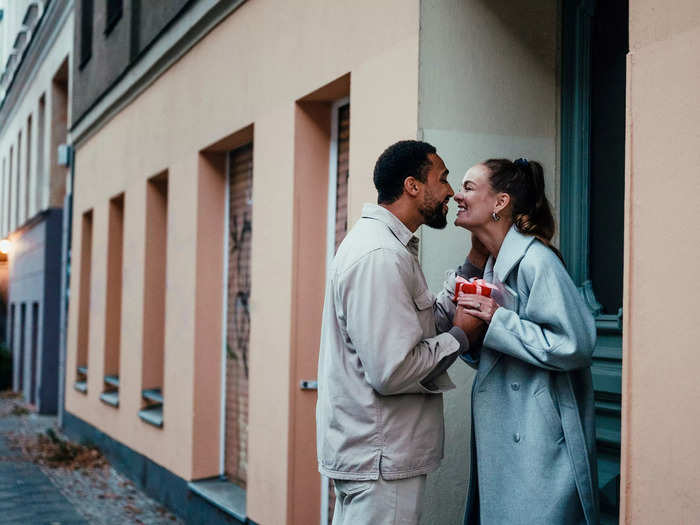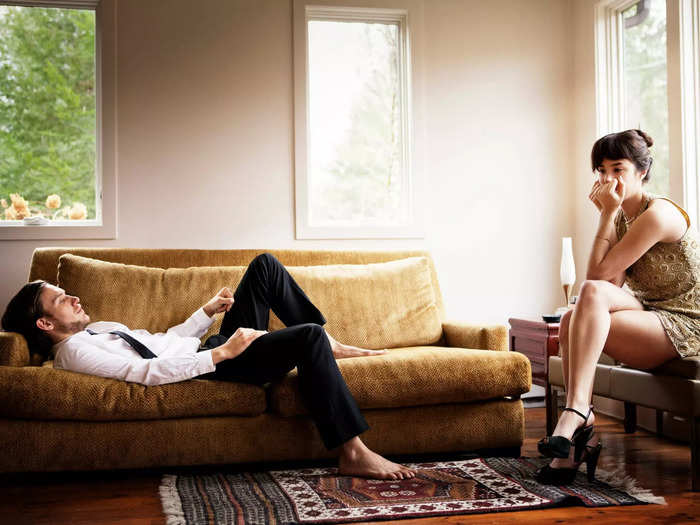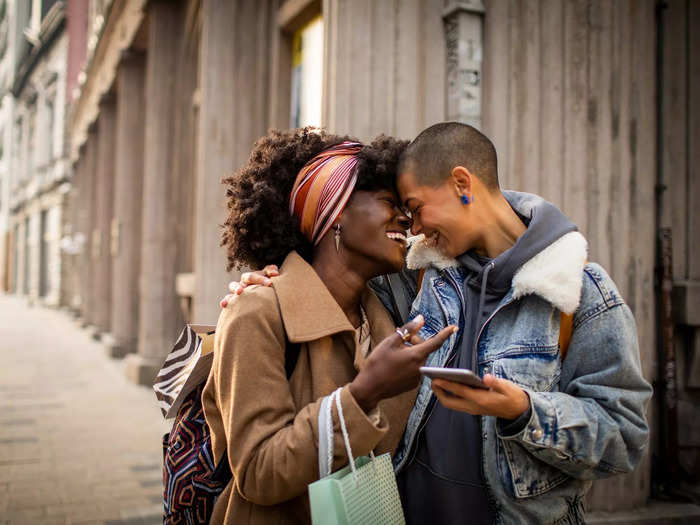Securely attached couples tend to have healthy relationships (stock image).Klaus Vedfelt/Getty Images
- There are four distinct types of attachment style: secure, anxious, and two kinds of avoidant.
- Anxious and avoidant people find intimacy more of a struggle than those who are secure.
Even the most reclusive of people need human attachment. That's why solitary confinement is such a successful form of torture — we are simply wired for connection, since the day we were born and and started crying for our mothers.
As we grow up, we learn how to form bonds with other people, and our early experiences with intimate relationships heavily impact how we approach attachment in the future.
It starts with how our parents related to us, then we are shaped further by other experiences with friends, teachers, and the first romantic relationships we have.
"We are run by stories, and we don't know what kinds of assumptions rule us until we pause and reflect," psychologist Perpetua Neo told Insider. "It could be upbringing, it could be a difficult experience, or attachment, that can lead to stories about us, such as 'I'm not good enough,' 'I'm not worthy,' 'I'm unlovable.'"
Our stories can place us anywhere on a wide spectrum of how we approach intimacy, but people can generally be divided into categories for how they attach to others: avoidant, anxious, and secure. Avoidant and anxious attachment styles are often the result of early trauma, while secure attachment tends to mean your childhood was healthy.
Psychotherapist Emily Morehead told Insider attachment style "plays into every relationship that we have and honestly how we view other humans" — relationships, workplaces, parenting, sexuality, and so on.
"The root of the problem does have a lot of links to that attachment style and those early relationships," she said. "A lot of the therapy that we do is helping people feel strong enough and brave enough to believe that they're worthy of learning that about themselves."
Here are the differences between the four attachment styles and how they affect your relationships.
Secure attachment
Alina Rudya/Bell Collective/Getty Images
An estimated 63% of the population have a healthy, secure attachment style.
Morehead said the security usually stems from having a healthy relationship with parents, where they were allowed to go out and explore the world as children, but also felt safe and protected.
These children had their needs met, and their parents "delighted in the need."
"A baby cries because they're hungry, thirsty, wet, whatever, and a parent meets that need and is happy to meet that need," she said. "There's not a coldness about meeting that need, and children then learn that caregivers can provide them comfort and support and that people are good."
In adulthood, this is mirrored in not smothering their partner, and trusting them to lead an independent life — while also knowing when to be honest, intimate, and supportive.
Secure people are better at accepting their partner's shortcomings, and are responsive to what they need. They don't manipulate or play games because their self-esteem is fairly high.
Even in conflict, they are better equipped to make their points while listening to the grievances of their partner without getting overly defensive, so they don't get sucked into a perpetual cycle of criticism and fighting.
Anxious attachment
Alao Yokogi/Getty
If someone grows up without the belief that their needs will be met, then they have "really hard relationships," Morehead said.
"We don't believe that we can ask for our needs to get met," she said. "We don't think that we can have needs, feelings, or emotions."
Anxious attachment, also referred to as preoccupied, is developed when a child has unpredictable caregivers — sometimes they are full of care and praise, but other times they are dismissive and cruel.
Morehead described it as "the imaginary spider web where they really want approval, they really want responsiveness, but sometimes they get it and sometimes they don't."
"They either get really attached and almost codependent or preoccupied in the relationship because they just want the love and affirmation all the time," she said. "These are the people that need to hear 'I love you' a lot."
They don't really live in the moment, but instead crave predictability, placing a lot of high hopes on their partner and getting attached to their potential. They expect their relationship to define them, rescue them, or complete them, and cling to their partner co-dependently, because they are afraid of being abandoned.
In an attempt to alleviate their relationship anxiety, they sometimes play games in their relationship to get attention. This can be acting out, trying to make their partner jealous, or withdrawing from the relationship.
Avoidant-dismissive and fearful-avoidant
Cavan Images/Getty Images
People with an avoidant attachment style completely avoid relationships altogether, or keep anyone new they meet at a distance. They may sabotage their blossoming romances out of nowhere, because they are scared their new partner will leave them — so they get in there first.
Avoidantly attached people can be divided into two categories: dismissive and fearful.
"People with an avoidant-dismissive attachment style tend to avoid emotional closeness and intimacy," licensed mental health counselor Steven Pinto told Insider. "They may be uncomfortable with depending on others or being depended upon."
Those with fearful-avoidant attachment, also known as disorganized attachment, "may desire closeness but also fear it," he added, "leading to confusion and ambivalence in relationships."
Dismissive avoidant people have the tendency to emotionally distance themselves from their partner and come off as overly-focused on themselves.
Fearful avoidant people are afraid of being too close or too distant from their partners, which means they can struggle to keep their emotions in check, get overwhelmed easily, and can have intense mood swings.
On the surface, someone with an avoidant attachment style may have looked like "the perfect child" who never complained. Really, Morehead said, they just became used to never having their needs met.
"They don't really want to trust others, they really don't want to depend on others," she said. "Their whole brain development is, I don't know how to regulate my emotions and no one else does. And so I'm just gonna keep to myself to stay out of the way."
In adulthood, these people suppress or hide their feelings, "and really believe that they have to do their emotions alone," she said.
So although they look like it's all fine on the outside, internally, "there's tremendous struggle."
How to break the cycle
Marko Geber/Getty Images
Humans are creatures of habit, and sometimes repeat behaviors to make up for the falls of their previous ones. In psychology this is called repetition compulsion, and it essentially means you're trying to fix the past by pursuing similar situations or people who once hurt you.
But for those willing to put in the work, there is an attachment style called "earned secure," Morehead said.
Morehead said there's often a stigma that these patterns people learn between the ages of zero to five are unchangeable. But she believes in the "neuro-plasticity" of the brain to be rewired.
"Beliefs are able to be healed as long as we are like really intentional about how we do that," she said. "You can heal yourself and you're not doomed if you did have a disorganized, avoidant, or anxious attachment. You can heal that and change that for yourself."
Morehead said healing comes when people become "really curious" about themselves, and learn to be "a detective on your own behaviors" — questioning why they get triggered by certain things, recognizing their patterns, and understanding their own needs, such as needing a nap, a break, or a conversation with a trusted friend.
"Breaking it down to that basic level physiological need," she said. "Once your body's regulated, you can understand the emotion and experience more."
The process can be overwhelming, exhausting, and sometimes scary, she added, but also incredibly liberating.
"So it needs a lot of tenderness," she said.
This article was first published in June 2018, but has been updated in May 2023 to include new experts and information.




